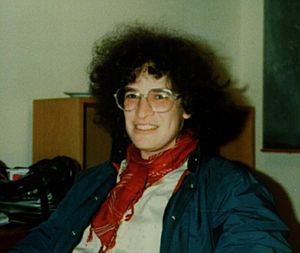Margaret Geller facts for kids
Quick facts for kids
Margaret J. Geller
|
|
|---|---|

Geller in 1981.
|
|
| Born |
Margaret Joan Geller
December 8, 1947 |
| Nationality | American |
| Alma mater | UC Berkeley (B.A., 1970) Princeton University (Ph.D., 1975) |
| Awards | Newcomb Cleveland Prize (1989) MacArthur Fellowship (1990) Klopsteg Memorial Award (1996) Magellanic Premium (2008) James Craig Watson Medal (2010) Russell Lectureship (2010) Lilienfeld Prize (2013) Karl Schwarzschild Medal (2014) |
| Scientific career | |
| Fields | Astrophysics: Galaxies and Cosmology |
| Institutions | Smithsonian Astrophysical Observatory |
| Thesis | Bright Galaxies in Rich Clusters: A Statistical Model for Magnitude Distributions. (1974) |
| Doctoral advisor | Jim Peebles |
| Doctoral students | Timothy Beers Marc Postman |
Margaret J. Geller (born December 8, 1947) is an American astrophysicist. She works at the Center for Astrophysics | Harvard & Smithsonian. Dr. Geller is famous for creating the first maps of the universe around us. She also studies how galaxies are connected to their surroundings. Her work helps us understand how matter is spread out in the universe.
Contents
Exploring the Universe: Margaret Geller's Career
Margaret Geller has made amazing maps of the universe's large structures. She earned her first degree in Physics from the University of California, Berkeley in 1970. Later, she received her Ph.D. in Physics from Princeton in 1974. Even though she first thought about studying solid state physics, her professor suggested she explore astrophysics at Princeton.
After finishing her studies, Dr. Geller worked as a research fellow. She was at the Center for Astrophysics | Harvard & Smithsonian and the Institute of Astronomy in Cambridge, England. From 1980 to 1983, she was an assistant professor at Harvard University. She then joined the permanent science team at the Smithsonian Astrophysical Observatory. This observatory is part of the Center for Astrophysics | Harvard & Smithsonian.
Dr. Geller is a respected member of many science groups. These include the American Association for the Advancement of Science and the American Physical Society. In 1990, she became a Fellow of the American Academy of Arts and Sciences. Two years later, she was chosen for the Physics section of the US National Academy of Sciences. She also served on the Council of the National Academy of Sciences from 2000 to 2003. She has received seven special honorary degrees for her achievements.
Mapping Galaxies and Dark Matter
Dr. Geller is well-known for her work in cosmology and extragalactic astronomy. These fields study the universe as a whole and galaxies beyond our own. Her main goal is to find out what the universe looks like. She also wants to understand how the patterns we see today came to be.
In the 1980s, she created groundbreaking maps of the nearby universe. One of these maps showed the Great Wall, a huge structure of galaxies. This map even inspired a famous artwork by Jasper Johns in 2020. Her SHELS project helps map how dark matter is spread throughout the universe. Dark matter is a mysterious substance that we can't see but know is there.
Using the 6.5-meter MMT telescope, she leads a deeper survey called HectoMAP. This project looks at the middle-aged universe. Dr. Geller has also created new ways to study the structure and mass of clusters of galaxies. She explores how these clusters relate to their surroundings.
Dr. Geller also helped discover hypervelocity stars. These are stars that move incredibly fast, almost fast enough to escape our galaxy. They might help scientists track where dark matter is located in the Milky Way.
Sharing Science Through Films and Talks
Margaret Geller has made several films to teach the public about space. Her 8-minute video Where the Galaxies Are (1989) was the first to show a graphic journey through the observed universe. It won a CINE Gold Eagle award.
A longer film, So Many Galaxies...So Little Time, came out later. This 40-minute film has amazing computer graphics that won an IEEE/Siggraph prize. It was even shown at the National Air and Space Museum.
Dr. Geller has given many talks to audiences all over the world. She has spoken twice at the main amphitheater of the Chautauqua Institution. Her speeches are so good that she is on NPR's list of "The Best Commencement Speeches, Ever."
In 2014, her story about becoming an astrophysicist was shared on The Story Collider podcast. It was called "Mapping the Universe."
Books Featuring Dr. Geller's Work
Margaret Geller's research is discussed in the book Physics in the Twentieth Century. She has also written popular articles that appear in other books. These include Beyond Earth: Mapping the Universe and Bubbles, Voids and Bumps in Time: The New Cosmology. In these books, her work is featured alongside other famous scientists.
Awards and Recognitions
Dr. Geller has received many awards and honors for her important contributions to science:
- 1989 Newcomb Cleveland Prize from the American Association for the Advancement of Science (with John P. Huchra)
- 1990 MacArthur Foundation Fellowship
- 1990 American Academy of Arts and Science
- 1992 National Academy of Sciences
- 1993 Helen Sawyer Hogg Lecture of the Canadian Astronomical Society
- 1996 Klopsteg Memorial Award of the American Association of Physics Teachers
- 1997 New York Public Library Library Lion
- 2003 La Medaille de l'ADION of Nice Observatory
- 2008 Magellanic Premium by the American Philosophical Society for her research on galaxy groupings.
- 2009 Honorary Degree (D.S.H.C.) from Colby College
- 2010 Henry Norris Russell Lectureship of the American Astronomical Society
- 2010 James Craig Watson Medal of the National Academy of Sciences
- 2013 Julius Edgar Lilienfeld Prize of the American Physical Society
- 2014 Karl Schwarzschild Medal of the German Astronomical Society
- 2014 Honorary Degree (D.S.H.C.) from Dartmouth College
- 2017 Honorary Degree (L.H.C.) from University of Turin
See also
 In Spanish: Margaret Geller para niños
In Spanish: Margaret Geller para niños

